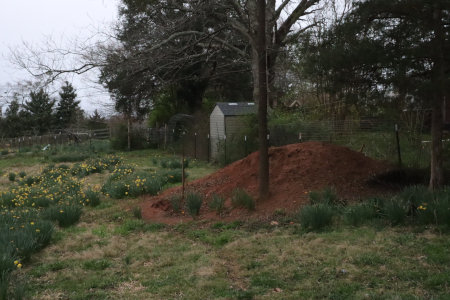Rain
- 3rd: 0.25"
- 5th: 0.7"
- 6th: 1.0"
- 7th: 0.2"
- 8th: 0.05"
- 9th: 0.3"
- 10th: drizzle
- 11th: 0.1"
- 14th: 0.8"
- 15th: 2.0"
- 22nd: 0.125"
- 30th: 0.1"
- 31st: 0.25"
- Total so far: 5.875 inches
Not Rain (and not measurable)
- 20th: light sleet
- 22nd: swirling snowflakes
Temperature
- range of nighttime lows: 7 to 53°F (-14 to 12°C)
- range of daytime highs: 23 to 69°F (-5 to 20.5°C)
Weather Notes:
The infamous frigid front blasted in during the early morning hours of the 23rd. It was 45°F (7°C) at midnight, but by sunrise it had dropped to 26°F (-3°C) and kept on dropping. By the next morning, the thermometer registered 7°F (-14°C). The frozen cold lasted for about five days before returning to more typical (for us) winter weather. And that was enough to freeze my winter garden dead. Some years are like that.
Harvesting
Most of these photos were taken before our deep freeze.

|
| Daikon radishes |

|
| Hopniss (ground nuts) |

|
| Lettuce and kale |

|
| Jerusalem artichokes |

|
| Turnips |
The turnips didn't come from the garden. Rather, these came out of the pasture. Dan planted a deer plot mix last August for a cover crop and winter foraging for the goats. Besides grasses, the mix included daikon, turnips, and forage mustard. So we benefit from it too.

|
| Turnips growing in the pasture. |
When the forecast predicted temps in the teens and below, I went out and harvested as many as I could to store in the pantry. Repeated freezing and thawing will turn them to mush.

|
| All of the largest turnips from the pasture. |
We enjoyed fresh greens in early December.

|
|
Sauteed greens (daikon, turnip, mustard, kale, and collards) with grated sweet potato. |

|
|
Turnips roasted with sweet potato |
I managed to get a half-gallon of kimchi made before the freeze. Now, I wish I'd made at least a gallon or more.

|
|
Kimchi: daikon roots and leaves, cabbage, turnips, Jerusalem artichoke, and ginger. |
We eat kimchi as a side dish or as a slaw-like salad. I experimented with sauerkraut, and discovered that it takes only a small amount of mayonnaise to make a kraut slaw( compared to making cole slaw with raw cabbage). Kimchi slaw makes a tasty salad too.
 |
| Kimchi slaw |
Warmer weather and rain is in the forecast for the tail end of the month. I'll update my December rainfall records after that.
I don't reckon anybody in the northern hemisphere has a garden left. Unless, someone is greenhouse growing? Hopefully, everyone's pantry is full.







































